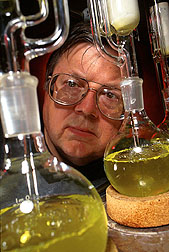Three New Crops for the Future
|
|
In the year 2020, midwestern farmland may blossom with pink, red, and purple flowers where corn and soybeans used to grow.
The names of the new crops—cuphea, milkweed, and Euphorbia lagascae—aren't 20th century household words, but these wild plants may have a future as industrial crops in the next millennium.
"The key to getting these alternative crops into greater use tomorrow is developing products and markets for their oil and fiber today," says Thomas P. Abbott, the leader of new crops research at the National Center for Agricultural Utilization Research in Peoria, Illinois.
Members of the Cuphea (koo-FEE-ah) genus produce an oil rich in medium-chain triglycerides, such as lauric and capric acid. Industrial oils made from these acids are valuable to the United States because they can replace others made from imported palm kernel and coconut oil. Lauric acid is used in foods—mostly vegetable shortenings—as a defoaming agent and a booster for soaps and detergents.
Until now, domesticating cuphea has been hindered by problems with seed shattering, stickiness, and dormancy. These problems are being overcome by Oregon State University plant breeder Steven J. Knapp. He has genetically redesigned cuphea, while ARS chemist Bliss S. Phillips is evaluating the new plants for their growing characteristics in the Midwest.
Beyond that, Phillips and other Peoria researchers will be processing cuphea's seed into oil, developing coproducts, and helping midwestern farmers plant the new crop with traditional farm equipment. Knapp's breeding work has been funded, in part, by ARS.
"If farmers don't need to purchase new equipment, they'll likely rotate planting cuphea with corn and soybeans every 3 years," says Phillips. Cuphea can help disrupt the life cycle of corn rootworms—pests that account for more pesticide use on U.S. row crops than any other insect. Corn rootworms can cost up to $1 billion a year in control and yield losses.
Milkweed and Euphorbia
ARS and private industry have taken comfort for years in their cooperative efforts to produce milkweed fiber. This fiber has been popular as a filling for comforters and pillows. But another use has been found by ARS chemist Rogers Harry-O'kuru. He and researchers at Washington State University have found that milkweed's leftover seedmeal can be used as an alternative for methyl bromide to control nematodes, the tiny worms that damage potatoes, tomatoes, and peppers.
Another "new" crop that's not yet commercialized is being studied for its potential to grow in the Midwest. Euphorbia lagascae gets its name from the Greek word euphobos, meaning "well-fed," because of its fat stems. The new crops research team is looking at developing markets for the oil as an ingredient in paints and coatings. At the same time, they are educating midwestern farmers about the potential value of growing these new crops.
At one time, "new crops" were defined as those crops not previously grown in this country. Few people remember that soybeans—now a mainstay of our agricultural system—were once considered a new crop. —By Linda McGraw, Agricultural Research Service Information Staff.
The research to develop coproducts for alternative crops is part of Crop Production, an ARS National Program (#306) described on the World Wide Web at http://www.nps.ars.usda.gov/programs/cppvs.htm.
Thomas P. Abbott, Bliss S. Phillips, and Rogers Harry-O'kuru are in the New Crops Research Unit, National Center for Agricultural Utilization Research, 1815 N. University St., Peoria, IL 61604; phone (309) 681-6533, fax (309) 681-6524.
"Three New Crops for the Future" was published in the December 1999 issue of Agricultural Research magazine.








